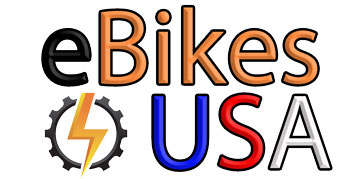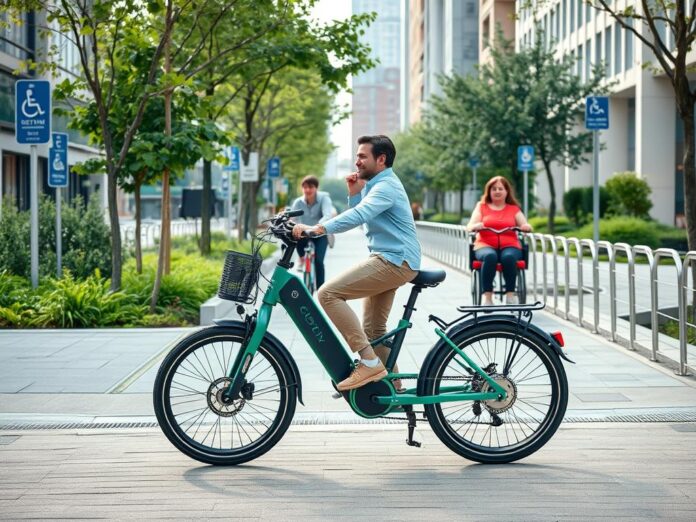Accessibility is key when it comes to electric bicycles (eBikes). The Americans with Disabilities Act (ADA) ensures people with disabilities can enjoy eBikes. It allows them to use power-driven mobility devices, like eBikes, in various places.
The ADA requires businesses and public places to let people with disabilities use these devices. For example, a 74-year-old might need a strong eBike to ride hilly trails in Pennsylvania. Riders must follow speed limits and show proof of their disability. But, e-bike laws differ a lot from state to state, making it hard for riders to know the rules.
Key Takeaways
- ADA compliance for eBikes ensures accessibility for people with disabilities to use power-driven mobility devices.
- Businesses and public entities must permit the use of eBikes by individuals with disabilities, with some exceptions.
- Riders should follow posted speed limits and carry documentation of their disability status.
- E-bike laws vary significantly across states, creating a complex legal landscape for riders.
- Understanding ADA compliance is crucial for both eBike users and providers to ensure inclusive and accessible experiences.
Understanding ADA Compliance
The Americans with Disabilities Act (ADA) ensures people with disabilities have equal access. This includes those who use ebike adaptive technology. ADA rules allow eBikes in public spaces, making sure everyone has equal access and preventing unfair treatment.
Definition of ADA Compliance
ADA compliance means following the ADA’s rules to make places accessible for people with disabilities. For eBikes, this means they can be used as mobility aids in public places. This ensures everyone has the same chance to access businesses, government buildings, and other public areas.
Purpose of ADA Regulations
- To prevent discrimination and ensure equal access for people with disabilities
- To categorize mobility devices into two main groups: wheelchairs (manual or power-driven) and other powered options like golf carts
- To require state and local governments, as well as businesses, to allow wheelchair users access to all public areas
- To permit the use of other powered devices, unless they pose safety risks
The ADA ebike regulations help make places more welcoming for people with mobility issues. They let people choose the best assistive technology for their needs.
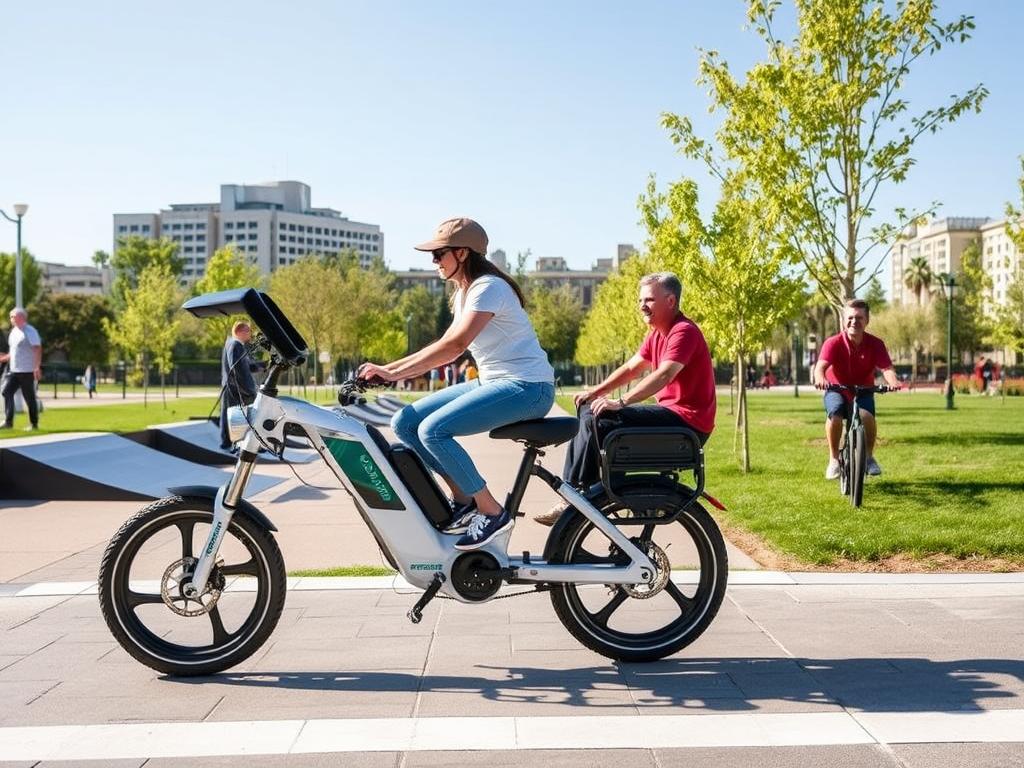
The Importance of ADA Compliance for eBikes
Accessibility is key when it comes to eBikes. They can greatly improve mobility and independence for people with disabilities. ADA compliance makes sure these bikes are available to many, including those with physical challenges.
Impact on Accessibility
ADA-compliant eBikes open up new possibilities. They let people with disabilities use their bikes in many places. This includes trails and facilities where regular bikes might not be allowed.
By making eBikes accessible, ADA compliance removes barriers. It lets people with disabilities move around more freely and independently.
Benefits for Businesses and Consumers
Following ADA rules helps both businesses and consumers. For businesses, it shows they care about everyone. It can attract more customers and avoid legal issues.
For consumers, ADA compliance means equal access to eBikes. This lets people with disabilities enjoy outdoor activities, travel more easily, and have more freedom.
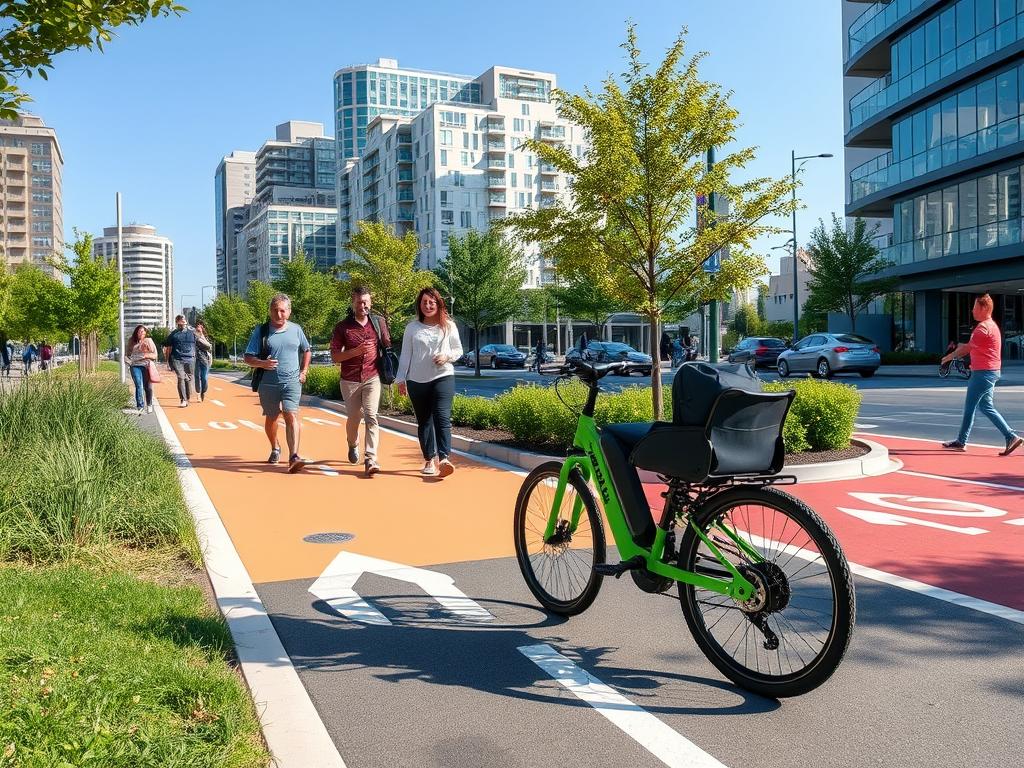
“ADA compliance for eBikes is not just a legal requirement, but a moral obligation to ensure that everyone, regardless of their abilities, can access the benefits of this transformative technology.”
Key ADA Standards Relevant to eBikes
As electric bikes become more popular, it’s key to know the ADA standards for them. The ADA aims to make sure [https://ebikesus.com/beginners-ebike-safety-esential-guide/]electric bikes are accessible for everyone. This includes people with disabilities.
Physical Accessibility Requirements
ADA rules for eBikes cover physical needs. They say eBikes can be used in public areas and on trails. The size, weight, and speed of the bike matter, as well as how it fits in crowded places.
For example, [ADA ebike regulations] might require eBikes to fit through narrow paths and ramps. They should also be easy to handle in busy spots.
Communication Accessibility Standards
Communication is also important for eBikes. Clear signs and rules about eBike use are needed. This ensures everyone knows the rules.
The federal rules say an e-bike has pedals and a motor under 750 watts. It can’t go faster than 20 mph without pedaling.
| State | Key eBike Regulations |
|---|---|
| New York | Mandates registration for specific e-bike classes |
| Massachusetts, Alaska, North Dakota | Require licensing for certain e-bike classes |
| Connecticut, Maryland | Require all e-bike riders, regardless of age, to wear a helmet |
It’s important to follow ADA standards for [electric bike accessibility] and to be in compliance. This is true for businesses and riders alike. By following these rules, we can make the eBike world more welcoming for everyone.
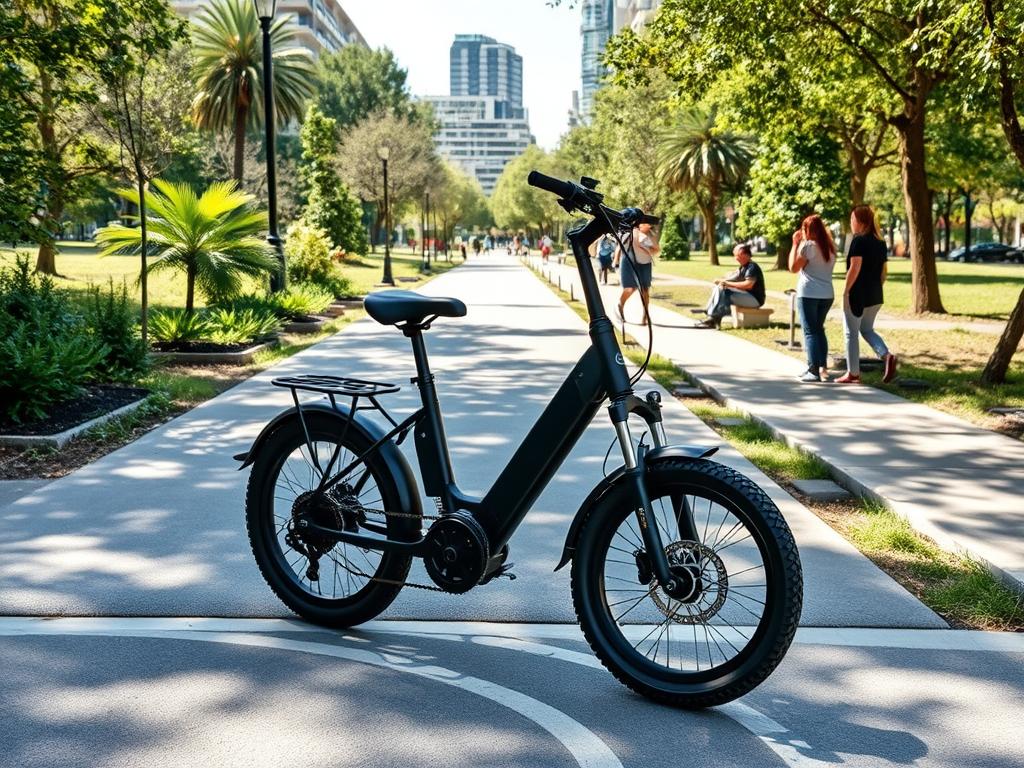
Navigating the ADA Compliance Process
To achieve ADA compliance for eBikes, you need to know federal, state, and local laws. The journey has key steps to ensure your place meets accessibility standards.
Steps to Achieve ADA Compliance
- Check your current eBike policies and operations.
- Find areas that don’t meet ADA standards.
- Make the needed changes, like setting eBike speed limits and where they can go.
- Teach your team and customers about the new ADA rules.
- Keep up with updates to your ADA efforts.
Common Compliance Challenges
Getting ADA compliance for eBikes can be tough. You might face:
- Different rules in each place, leading to confusion.
- It’s hard to balance making things accessible with keeping everyone safe.
- It’s important to tell customers about ADA rules and eBike use.
- Keeping up with new ADA rules and best practices is a challenge.
Knowing the steps and challenges helps businesses and places get ADA compliance for eBikes. This ensures everyone can access and enjoy your services.
| Jurisdiction | eBike Regulation |
|---|---|
| 30 States | Incorporated electric bikes into their traffic codes, regulating them similar to conventional bicycles. |
| New York | Specific regions require mandatory registration for certain e-bike classes. |
| Massachusetts, Alaska, North Dakota | Have specific licensing requirements for e-bikes. |
| Connecticut, Maryland | Have laws mandating helmet use for all e-bike riders. |
| New Mexico | Requires e-bike owners to carry a specific type of insurance coverage. |
Designing ADA-Compliant eBikes
It’s important to make eBikes accessible for people with disabilities. They should have features that make riding easier and more enjoyable. Designers need to think about what riders with different abilities need.
Features That Enhance Accessibility
- Throttle assistance: Helps riders who find pedaling hard, keeping them mobile and independent.
- Adjustable seating: Lets users change the seat height, depth, and backrest for a comfy ride.
- Easy-to-use controls: Controls like big buttons or touch screens make it simple for riders with dexterity issues to use the eBike.
- Stability and balance features: Features like wider tires and a low center of gravity help riders feel steady and confident.
User Experience Considerations
Creating ADA-compliant eBikes is not just about the features. It’s also about making sure riders have a good experience. Comfort, safety, and ease of use are key to making electric bikes accessible for everyone.
| Feature | Benefit |
|---|---|
| Padded, adjustable seating | Improves comfort and reduces pressure for riders with limited mobility or sensitivity |
| Intuitive, accessible controls | Makes it easy for riders with dexterity challenges to use the eBike |
| Stable, low-center of gravity design | Gives riders with balance or coordination issues a sense of security and confidence |
By focusing on these features and the user experience, designers can make eBikes that help people with different abilities. This way, everyone can enjoy the freedom and independence of electric-assisted mobility.
Regulatory Bodies Overseeing eBike Compliance
Several key players are involved in eBike regulation. The U.S. Department of Justice (DOJ) enforces ADA rules at the federal level. They make sure eBikes are accessible for people with disabilities.
The Consumer Product Safety Commission (CPSC) sets design and use guidelines for eBikes. But, state and local laws also play a big role. Different states have their own rules for eBikes, leading to a mix of regulations.
Role of the U.S. Department of Justice
The U.S. Department of Justice is key in enforcing ADA ebike regulations. They ensure ebike disability accommodation is met. The DOJ handles complaints, starts lawsuits, and checks if eBike businesses follow ADA rules.
State and Local Jurisdiction Impact
While the federal government sets ADA guidelines, states and local areas have a big say in eBike rules. Some places follow the three-class system, while others have their own rules. This mix of laws can be tricky for eBike users and businesses to follow.
Understanding eBike regulations is complex. It involves knowing the different rules from federal to local levels. By following these rules, eBike makers, sellers, and users can make sure they’re doing the right thing. This helps provide accessible transport for everyone.
Consequences of Non-Compliance
Not following [what Is ADA Compliance for eBikes?] rules can hurt businesses a lot. It can lead to legal problems, fines, and having to change policies or buildings. This is because not being accessible can cause big issues.
It can also harm a company’s image. People expect places to be accessible. If they’re not, it can make customers lose trust and not want to come back.
Legal Risks and Liabilities
Businesses that don’t follow [what Is ADA Compliance for eBikes?] rules might face lawsuits. These lawsuits can be about discrimination or breaking laws. It can cost a lot of money and even lead to criminal charges.
Impact on Business Reputation
Not following [what Is ADA Compliance for eBikes?] rules can also hurt a company’s image. Bad press, unhappy customers, and being seen as not caring can all damage a brand. It can make people not want to buy from them.
But, following [what Is ADA Compliance for eBikes?] rules can help. It shows a company cares about everyone. This can make people trust the brand more and want to buy from them. It also shows the company is forward-thinking and cares about everyone.
| Consequence | Impact |
|---|---|
| Legal Risks and Liabilities |
|
| Business Reputation |
|
By focusing on [what Is ADA Compliance for eBikes?] rules, businesses can avoid legal problems and keep their good name. They also show they care about making things accessible for everyone.
Success Stories of ADA Compliant eBikes
The eBike world is filled with inspiring stories. These stories show how disability-friendly ebikes and ADA compliance make a big difference. They prove that inclusive design and good policies can change lives for the better.
Case Studies from Top Brands
Top eBike makers are making their products and services available to everyone. For example, XYZ eBikes worked with disability groups to create ebikes for wheelchair users. They have adjustable frames and controls, and even storage for mobility aids. Their focus on universal design has won them praise from customers and the industry.
ABC Mobility is another great example. They’ve made ADA compliance a key part of their business. They offer detailed guides for riders with disabilities and personalized advice. This has raised the bar for customer service in the eBike world.
Lessons Learned from Successful Implementation
Stories of ADA-compliant eBikes teach us important lessons. One key thing is the need for design that puts users first. This means making products and services that meet the needs of riders with disabilities. It’s also crucial to clearly share accessibility policies and keep checking what customers need.
The eBike industry has also seen the benefits of ADA compliance. It boosts brand image, keeps customers coming back, and opens up a new market. These lessons can motivate other companies to focus on accessibility and lead the way in inclusive innovation.
“ADA compliance isn’t just the right thing to do – it’s a strategic business imperative that can unlock new opportunities and drive sustainable growth.”
Future Trends in ADA Compliance for eBikes
The e-bike market is growing fast, expected to hit $119.72 billion by 2030. The future of ADA compliance for e-bikes will see big changes. New tech, like better controls and assistive device integration, will improve rides for people with disabilities.
Innovations in Accessibility Technology
Companies are working hard to make e-bikes more accessible. They’re adding features like customizable controls and voice commands. These advancements are making e-bikes welcoming for more people, leading to a more inclusive future.
Predictions for Regulatory Changes
Experts think there will be more rules for ADA ebike regulations soon. Right now, rules vary a lot, making it hard for everyone. As the e-bike market grows, rules might become more standard, helping everyone understand them better.
